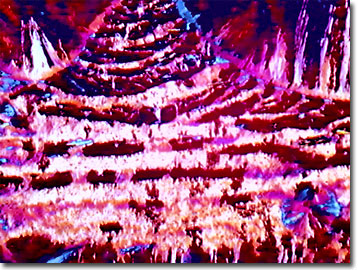Polarized Light Digital Image Gallery
Orotic Acid
Orotic acid plays a central role in the metabolism of folic acid and vitamin B-12, and may enhance the transportation of minerals across cell membranes. Found naturally in whey and root vegetables, such as beets, turnips, and carrots, orotic acid is easily destroyed by water and sunlight.

View a second image of orotic acid.
To biochemists, orotic acid has many synonyms including 1,2,3,6-tetrahydro-2,6-dioxo-4-pyrimidinecaboxylic acid, uracil-6-carboxylic acid, and 2,6-dihydroxy-4-pyrimidinecarboxylic acid, while to biologists it is also known as animal galactose factor or orotonin. Featuring 5 carbons, 4 hydrogens, 2 nitrogens, and 4 oxygen atoms per molecule, orotic acid has a molecular weight of 110. As a white crystalline powder, at 345 degrees Celsius it decomposes and the fragile chemical is incompatible with strong oxidizing agents.
If inhaled or ingested in its purified or synthesized form, orotic acid is listed as toxic. The biochemical is reportedly a remedy for liver-related complications, premature aging, and helps for treating the symptoms of multiple sclerosis. The United States Food and Drug Administration has not set a recommended daily allowance (RDA) for orotic acid and apparently, it is not available for retail sale in the United States as a dietary supplement. The synthesized version is marketed as the calcium orotate, and when combined with elemental calcium, increases calcium absorption and helps prevent osteoporosis. For patients with urea cycle defects, an assay of the urine for orotic acid is conducted. Apparently, as revealed from radioactive isotope tracer studies, orotic acid is incorporated into RNA as uridine and is able to cross the placental bridge for synthesis of fetal RNA also.
As a non-essential vitamin-like substance, orotic acid is biosynthesized by intestinal flora of the human body. A genetic mistake in the pyrimidine metabolic process results in enzyme deficiencies and a disease condition known as orotic aciduria. With this hereditary defect, there is an accumulation of orotic acid in the body and high levels detectable in the urine (up to 1.5 grams per day are excreted). Symptoms of the disease include megaloblastic anemia, retardation in growth and mental capabilities, and crystal formation in the urine. Surprisingly, cancer research has revealed that orotic acid is a powerful tumor promoter, particularly in the liver. Orotic acid is used in cosmetics for skin moisturizing and anti-aging creams, where it is readily absorbed by epithelial cells and penetrates skin tissues to provide nourishment. In the long battles against HIV/AIDS and cancer, there are some indications that antiproliferative agents, such as brequinar, may hold promise by inhibiting the enzyme that converts dihydro-orotate into orotic acid, which is critical for the formation of uridine and cytidine, both required for DNA and RNA synthesis.
Contributing Authors
Omar Alvarado, Thomas J. Fellers and Michael W. Davidson - National High Magnetic Field Laboratory, 1800 East Paul Dirac Dr., The Florida State University, Tallahassee, Florida, 32310.
BACK TO THE POLARIZED LIGHT IMAGE GALLERY
BACK TO THE DIGITAL IMAGE GALLERIES
Questions or comments? Send us an email.
© 1995-2025 by Michael W. Davidson and The Florida State University. All Rights Reserved. No images, graphics, software, scripts, or applets may be reproduced or used in any manner without permission from the copyright holders. Use of this website means you agree to all of the Legal Terms and Conditions set forth by the owners.
This website is maintained by our
Graphics & Web Programming Team
in collaboration with Optical Microscopy at the
National High Magnetic Field Laboratory.
Last Modification Friday, Nov 13, 2015 at 01:19 PM
Access Count Since September 17, 2002: 16595
Visit the website of our partner in introductory microscopy education:
|
|
